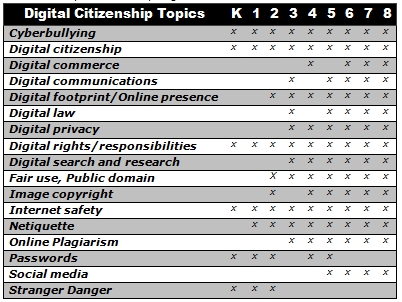Education has changed. No longer is it contained within four classroom walls or the physical site of a school building. Students aren’t confined by the eight hours between the school bell’s chimes or the struggling budget of an underfunded program.
Now, education can be found anywhere, by teaming up with students in Kenya or Skyping with an author in Sweden or chatting with an astrophysicist on the International Space Station. Students can use Google Earth to take a virtual tour of a zoo or a blog to collaborate on class research. Learning has no temporal or geographic borders, available wherever students and teachers find an internet connection.
This vast landscape of resources is offered digitally (more and more), freely (often), and equitably (hopefully), but to take that cerebral trek through the online world, children must know how to do it safely, securely, and responsibly. This used to mean limiting access to the internet, blocking websites, and layering rules upon rules hoping (vainly) that students would be discouraged from using an infinite and fascinating resource.
It didn’t work.
Best practices now suggest that instead of cocooning students, we teach them to be good digital citizens, confident and competent in 17 areas:
- Cyberbullying
- Digital citizenship
- Digital commerce
- Digital communication
- Digital footprint
- Digital law—plagiarism, copyrights, fair use, public domain
- Digital privacy
- Digital rights and responsibilities
- Digital search/research
- Fair use/Public domain
- Image copyrights
- Internet safety
- Netiquette
- Online plagiarism
- Passwords
- Social Media
- Stranger danger
But how do you do that? How do you teach kindergarteners to beware of the digital neighborhood, the home of Legoland and virtual pets? How do you teach fifth graders to be careful when the cool middle schoolers aren’t? How do you teach eighth graders that they aren’t invincible despite the anonymity of the world wide web.
It’s easier than you think. Do it the same way parents have always taught students to be safe in their physical neighborhoods: a little bit at a time, with age-appropriate information that’s repeated like a mantra:
Don’t talk to strangers. Look both ways before crossing the (virtual) street. Don’t go places you don’t know. Play fair. Pick carefully who you trust. Don’t get distracted by bling. Sometimes, stop everything and take a nap.
Here’s my schedule grade-by-grade:
 One of my favorites of all the above, is ‘digital rights and responsibilities’. With great virtual wealth comes obligations. You can’t have one without the other. It’s never too early to start that conversation.
One of my favorites of all the above, is ‘digital rights and responsibilities’. With great virtual wealth comes obligations. You can’t have one without the other. It’s never too early to start that conversation.
How do you do it, in your school?
For more, check out the new K-8 Digital Citizenship Curriculum. 70 pages with how to teach everything, including over 40 projects.
Jacqui Murray has been teaching K-18 technology for 30 years. She is the editor/author of over a hundred tech ed resources including a K-12 technology curriculum, K-8 keyboard curriculum, K-8 Digital Citizenship curriculum. She is an adjunct professor in tech ed, Master Teacher, webmaster for four blogs, an Amazon Vine Voice, CSTA presentation reviewer, freelance journalist on tech ed topics, contributor to NEA Today, and author of the tech thrillers, To Hunt a Sub and Twenty-four Days. You can find her resources at Structured Learning.




































